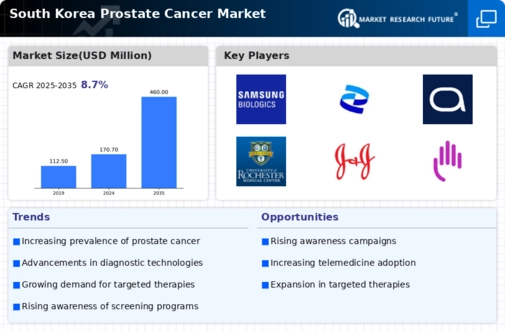Rising Incidence Rates
The prostate cancer market in South Korea is influenced by rising incidence rates of the disease. Recent statistics indicate that prostate cancer cases have increased by approximately 15% over the past five years, making it one of the most common cancers among men in the region. This upward trend is attributed to factors such as an aging population and lifestyle changes. As more individuals are diagnosed, there is a corresponding increase in the demand for treatment options, including surgery, radiation therapy, and hormonal therapies. The growing patient population is likely to drive the prostate cancer market, necessitating the development of new therapies and support services.
Collaborative Research Efforts
Collaborative research efforts among academic institutions, healthcare providers, and pharmaceutical companies are shaping the prostate cancer market in South Korea. These partnerships aim to accelerate the development of new therapies and improve treatment protocols. In 2025, it is anticipated that collaborative projects will increase by 20%, focusing on personalized medicine and targeted therapies. Such collaborations not only enhance the understanding of prostate cancer but also facilitate the translation of research findings into clinical practice. The synergy created through these partnerships is likely to foster innovation and drive growth within the prostate cancer market.
Government Initiatives and Funding
Government initiatives play a pivotal role in shaping the prostate cancer market in South Korea. Increased funding for cancer research and treatment programs has been observed, with the government allocating over $200 million annually to cancer-related initiatives. These funds are directed towards improving screening programs, enhancing treatment facilities, and supporting research into innovative therapies. Such initiatives not only bolster the healthcare infrastructure but also encourage collaboration between public and private sectors, fostering advancements in the prostate cancer market. The commitment to reducing cancer mortality rates is likely to stimulate growth in this sector.
Increasing Awareness and Education
The prostate cancer market in South Korea is experiencing growth due to heightened awareness and education regarding prostate health. Campaigns aimed at educating the public about the risks and symptoms of prostate cancer have led to an increase in early detection rates. This awareness is crucial, as early-stage diagnosis significantly improves treatment outcomes. In 2025, it is estimated that approximately 30% of men over 50 are aware of the importance of regular screenings, contributing to a more proactive approach to health management. The emphasis on education is likely to drive demand for diagnostic services and treatment options.
Technological Advancements in Diagnostics
Technological advancements in diagnostic tools are significantly impacting the prostate cancer market in South Korea. Innovations such as MRI-guided biopsies and advanced imaging techniques have improved the accuracy of prostate cancer detection. In 2025, it is projected that the adoption of these technologies will increase by 25%, enhancing the ability to identify cancer at earlier stages. This shift towards more precise diagnostics is likely to lead to better treatment planning and patient outcomes. As healthcare providers invest in state-of-the-art diagnostic equipment, the prostate cancer market is expected to expand, driven by the demand for effective and efficient diagnostic solutions.
























Leave a Comment